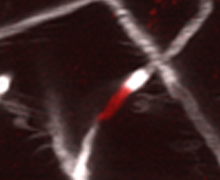Mechanism of CAR T Cell Neurotoxicity
 This project studies the mechanism of neurologic toxicity in chimeric antigen receptor (CAR) T cell therapy. CAR T cells are genetically modified, patient derived T cells that use the CAR to recognize and destroy malignant target cells. Although CAR T therapy has shown impressive results against leukemia and lymphoma, approximately 30-40% of patients experience neurologic side effects in the first month after receiving CD19-targeted CAR T cells. This includes cognitive disturbances, seizures, and in rare cases fatal cerebral edema. Systemic cytokine release syndrome after CAR T cell infusion is a well-established risk factor for neurotoxicity, but the connection between systemic inflammation and brain dysfunction is poorly understood.
This project studies the mechanism of neurologic toxicity in chimeric antigen receptor (CAR) T cell therapy. CAR T cells are genetically modified, patient derived T cells that use the CAR to recognize and destroy malignant target cells. Although CAR T therapy has shown impressive results against leukemia and lymphoma, approximately 30-40% of patients experience neurologic side effects in the first month after receiving CD19-targeted CAR T cells. This includes cognitive disturbances, seizures, and in rare cases fatal cerebral edema. Systemic cytokine release syndrome after CAR T cell infusion is a well-established risk factor for neurotoxicity, but the connection between systemic inflammation and brain dysfunction is poorly understood.
To study the mechanisms of neurotoxicity, we have developed an immunocompetent mouse model. After treatment with high dose CD19-directed murine CAR T cells, mice develop motor and balance difficulties, as well as brain microhemorrhages. Surprisingly, we found that >10% of cortical capillaries are obstructed by white blood cells during neurotoxicity. This was accompanied by capillary remodeling and decreased vessel coverage by pericytes.
We are now working to uncover the molecular mechanisms that cause white blood cells to plug capillaries during neurotoxicity. We use in vivo two-photon imaging in mice to determine which cell types cause the capillary plugging – the mouse’s own or the transferred CAR T cells? We will then measure how CAR T cell treatment changes the expression of adhesion molecules in brain capillary endothelial cells and in leukocytes, and test whether blockade of these adhesion interactions can prevent capillary plugging and neurotoxicity.
